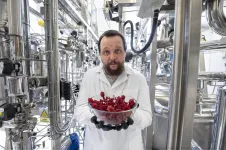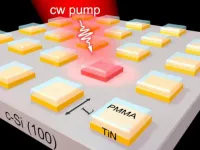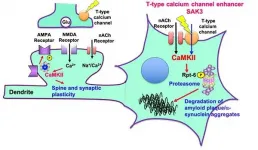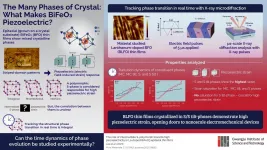(Press-News.org) Prolonged exposure to antibiotics leads to the gain of bacteria's ability to defeat the drugs designed to fight them. Thus, if such antibiotic-resistant bacteria cause the infection, the only chance to use a specialized virus called phage infecting specific bacteria species. It is a powerful weapon against deadly diseases. At the same time, the effective treatment depends on factors that would not be suspected for years to impact the successful therapy. Recently, researchers from the Institute of Physical Chemistry, Polish Academy of Sciences led by dr. Jan Paczesny and Professor Robert Holyst explained why, in some cases, phage therapies might fail. They have revealed that the material used to store the phages has a tremendous effect on their number in the formulation used for treatment.
Antibiotics were used for many decades to treat various bacterial infections. Thanks to them, many diseases are easier to fight. Unfortunately, as long as antibiotics are widely applied in medical treatment, many bacteria develop resistance to antibiotics. As an effect, some of them can defeat all antibiotics that are currently available in the pharmaceutical market. What if someone infected with highly resistant bacteria and even the most potent antibiotic - vancomycin, does not work? Still, there is a chance to win the mortal fight. The solution is based on applying bacteriophages, also called phages. They are specialized viruses that can infect and kill bacteria without adverse effects on humans. That therapy is called Last Chance Viral Therapy and can be used against chronic diseases, e.g., urinary tract inflammation. Unfortunately, despite beneficial treatment and numerous trials, the number of active bacteriophages in the solution for injection can drastically decrease, making the treatment ineffective. Recently, scientists from the Institute of Physical Chemistry, Polish Academy of Scientists led by dr. Jan Paczesny and Professor Robert Holyst found out that the drop of the phage's concentration in a formulation depends on the container's properties used to store them. Surprisingly, depending on the polymer that is used to make the container, the phage can "sit" on the polymers' surface or not. That is caused by hydrophobicity, which is one of the most critical factors governing the adsorption of phages on surfaces. As an effect, even the same sets of containers purchased from different suppliers and manufacturers can have other superficial properties. Then, the internal walls can scavenge all phages from the bulk, leading to a reduced concentration in the formulation.
So, the number of active phages can drastically drop even many orders of magnitude depending on the containers' type used for the phages store. These differences can be caused by the additives used in polymers manufacturing, like plasticizers or slip agents. For that reason, researchers tested several types of polypropylene-based containers dedicated to laboratory use.
Dr. Paczesny remarks, "We verified if leachables are responsible for the observed effect of a decreasing number of active phages in polypropylene containers. We considered the possibility that leachables released from "unsafe" tubes could deactivate phages or leachables from "safe" tubes could protect phages against external factors (e.g., temperature). Next, we examined the adsorption of virions on the polypropylene containers' walls as a mechanism responsible for the observed effect. Uncontrolled adsorption of phages and their subsequent disappearance from the solution can cause severe errors and unrepeatable results. This is extremely important for phage therapies."
Researchers tested various containers with standard operations like mixing, heating, or prolonged storage of active phages. They presented that the drop of active phages number in bulk is dependent mainly only on plastic properties like wettability. They have also investigated the effect of phages' physical structure, including electrostatic properties of the phages' surface. Still, their results clearly point out that the type of plastic has tremendous meaning comparing the surface potential of phages when it comes to phages settling onto containers' walls. In this work, researchers proposed particular solutions for containers having specific properties like a treatment with a particular surfactant limiting the phage's adsorption onto the container surface. Within detailed studies, it was presented that their agglomeration causes the drop of the number of active phages in bulk onto containers' walls. Researchers have explained why phages tend to adsorb on more hydrophobic surfaces. When the aqueous solution with phages is stored in the container made with hydrophobic material like PP, the aggregation of phages onto walls is profitable energetically than their stay in the solution. It is caused by the water properties that have limited contact with hydrophobic walls when they are covered with phages.
"Our findings are of crucial importance not only for phage-related studies. Lack of reproducibility of measurements is becoming the most significant threat to the scientific community. Scientists might not even be aware that PP tubes vendor might provide seemingly the same product differing significantly from batch to batch. Sometimes this can lead to false conclusions. Or, as in the case of phages--it can prohibit the development of essential technologies due to low efficiency caused solely by improper containers." - claims dr. Paczesny
The studies presented in the Scientific Reports on 1st April 2021 present an important issue about the effectiveness of the Last Change Viral Phage Therapy. In case of sudden need of its application, the choice of container for the phages store seems to be the least important. However, as we can see here, such a factor has a tremendous impact on the number of active phages in the solution determining successful therapy.
Such a small step for phages can be a significant step for a patient who struggles with bacteria that can be killed only with phages. Presented data and proposed solutions solve non-repeatable results in infection treatment with phages, but, for sure, will improve all phage-based projects.
INFORMATION:
This study was supported by the National Science Centre Poland (NCN) within SONATA BIS Project No. 2017/26/E/ST4/00041.
Tsukuba, Japan - Depression is a worldwide problem, with serious consequences for individual health and the economy, and rapid and effective screening tools are thus urgently needed to counteract its increasing prevalence. Now, researchers from Japan have found that artificial intelligence (AI) can be used to detect signs of depression.
In a study published this month in BMJ Open, researchers from University of Tsukuba have revealed that an AI system using machine learning could predict psychological distress among workers, which is a risk factor for depression. ...
Atomic nuclei contain enormous energy that can be extracted through their fission mechanism, for example, as a result of the radioactive decay of uranium or plutonium nuclei. Likewise, a quantum of light of several electron-volts (2.4 eV in a laser pointer with a green beam) has colossal energy. If all photons were absorbed by matter, then its temperature could reach several thousand degrees. However, in practice this does not happen. The reason is the weak light-matter interaction due to the fact that the wavelength of light (500 nm) is a thousand times larger than the size of an emitting / absorbing atom (0.5 nm). It is this physical mechanism that prevents the destruction of matter when illuminated. The efficiency of light absorption increases ...
Researchers have identified a new treatment candidate that appears to not only halt neurodegenerative symptoms in mouse models of dementia and Alzheimer's disease, but also reverse the effects of the disorders.
The team, based at Tohoku University, published their results on June 8 in the International Journal of Molecular Sciences. The treatment candidate has been declared safe by Japan's governing board, and the researchers plan to begin clinical trials in humans in the next year.
"There are currently no disease-modifying therapeutics for neurodegenerative disorders such as Alzheimer's disease, Lewy body dementia, Huntington ...
As our society and transportation systems become increasingly electrified, scientists worldwide are seeking more efficient and higher capacity storage systems. Researchers at KAUST have made an important contribution by modifying lithium-sulfur (Li-S) batteries to suppress a problem known as polysulfide shuttling.
"The bottleneck in the utilization of renewable energy, especially in transportation, is the need for high-density batteries," says Eman Alhajji, Ph.D. student and first author of the research paper.
Li-S batteries have several potential advantages over ...
Bobtail and bottletail squids are tiny marine invertebrates that are found throughout the world's oceans and are useful model animals for research
There are 68 recognized species of bobtail squid and five recognized species of bottletail squid, but the timing of their divergence from one another is still relatively unknown
Researchers at OIST, Hiroshima University and the National University of Ireland Galway, collected 32 species of bobtail and bottletail squids
They looked at the genetic variations across the entire genomes of these species to estimate their evolutionary relationships
The results showed that the divergence of these species aligned with major ...
Tel Aviv University's groundbreaking technology may revolutionize the treatment of cancer and a wide range of diseases and medical conditions. In the framework of this study, the researchers were able to create a new method of transporting RNA-based drugs to a subpopulation of immune cells involved in the inflammation process, and target the disease-inflamed cell without causing damage to other cells.
The study was led by Prof. Dan Peer, a global pioneer in the development of RNA-based therapeutic delivery. He is Tel Aviv University's Vice President for Research and Development, head of the Center for Translational Medicine and a member of both the Shmunis School of Biomedicine and Cancer Research, George S. Wise Faculty ...
What if electricity could be squeezed out of something? It turns out some materials have this property. Piezoelectricity is the electric charge that accumulates in certain solids when mechanical stress is applied on them. Piezoelectric materials, like bismuth ferrite thin films, when grown on a single lanthanum aluminate substrate give rise to highly strained epitaxial thin films that exhibit excellent electromechanical and ferroelectric properties. In bismuth ferrite thin films "doped" or polluted with lanthanum (BLFOs), piezoelectricity is attributed to the presence of "mixed-phase structures" with stripe patterns.
The formation of stripe patterns and controlling the mixed-phase structures of BLFO have been the ...
A FLEET theoretical study out this week has found a 'smoking gun' in the long search for the topological magnetic monopole referred to as the END ...
HARWELL, UK (29 June 2021) Researchers working on the Faraday Institution project on the recycling of lithium-ion batteries (ReLiB) at the Universities of Leicester and Birmingham have solved a critical challenge in the recovery of materials used in electric vehicle batteries at the end of their life, enabling their re-use in the manufacture of new batteries. The new method, which uses ultrasonic waves to separate out valuable material from the electrodes, is 100 times quicker, greener and leads to a higher purity of recovered materials relative to current separation methods.
The research has been published in Green Chemistry and the team have applied for a patent for the technique.
To ...
Patients with mild Covid-19 infections experience a significantly increased longer lasting reduced sense of taste and smell. This is also the case for long-term shortness of breath, although relatively few people are affected. And women and the elderly are particularly affected. This is shown by new research findings from Aarhus University Aarhus University Hospital and Regional Hospital West Jutland
The last 14 months have taught us that there are different symptoms and outcomes of Covid-19. However, the vast majority of people who fall ill with Covid-19 experience mild symptoms and get over ...





